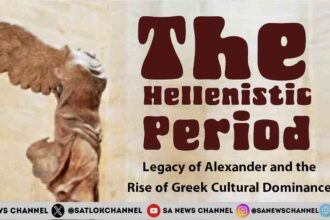The Phoenicians were a remarkable seafaring people who profoundly shaped the ancient Mediterranean world. Between 1500 BCE and 300 BCE, they built vast trade networks, invented the world’s first widely used alphabet, and spread culture, ideas, and goods across continents. Though their homeland was small, centered in modern Lebanon and coastal Syria, the Phoenicians’ influence far outweighed their geographic size. They are often remembered not for military conquests, but for innovation, commerce, and cultural diffusion.
- Homeland and Early Development
- Mastery of Shipbuilding and Navigation
- Foundation of Colonies
- Wealth and Trade Networks
- The Phoenician Alphabet
- Religion and Society
- Political History and Decline
- The Rise and Fall of Carthage
- Modern Discoveries and Legacy
- Small in territory but vast in impact
- Spiritual Reflection: The history and the worship
- FAQs about the history of the Phoenicians
- 1. Who were the Phoenicians?
- 2. What were the main cities of Phoenicia?
- 3. What is the Phoenician alphabet?
- 4. What goods did the Phoenicians trade?
- 5. What happened to the Phoenicians?
- Connect With Us on the Following Social Media Platforms
Homeland and Early Development
The Phoenicians inhabited a narrow coastal strip bordered by the Mediterranean Sea to the west and the towering Lebanon Mountains to the east. Their cities, such as Byblos, Sidon, Tyre, and Arwad, developed as independent city-states. These were not a unified kingdom but a network of politically autonomous cities bound by shared language, religion, and commercial interests.

With little fertile land, the Phoenicians turned to the sea for opportunity. From the start of the Bronze Age, they built highly advanced ships and developed sophisticated navigation techniques, allowing them to dominate Mediterranean maritime trade for centuries.
Mastery of Shipbuilding and Navigation
The Phoenicians are credited with advancing naval architecture, including the invention of the bireme, a two-tiered oared ship that was faster and more maneuverable than earlier designs. They also mastered star-based navigation and carefully studied winds and currents, enabling long voyages that many contemporaries thought impossible.

By the late first millennium BCE, Phoenician merchants ventured throughout the Mediterranean, reaching as far as Spain, the British Isles in search of tin, North Africa, and possibly even the west coast of Africa. Ancient historians like Herodotus wrote that Phoenician sailors may have circumnavigated Africa centuries before the Portuguese, though the evidence for this remains debated.
Foundation of Colonies
To support their growing trade empire, the Phoenicians founded numerous colonies and trading posts along the Mediterranean coast. Among the earliest was Gadir (modern Cádiz in Spain), established to control access to the tin-rich mines of the Iberian Peninsula. Malta, Sicily, Sardinia, and the coast of North Africa were dotted with Phoenician outposts.
The most famous colony was Carthage, founded around 814 BCE by settlers from Tyre. Over time, Carthage grew to become a powerful city-state in its own right and would later challenge Rome for dominance of the western Mediterranean.
Wealth and Trade Networks
The wealth of the Phoenicians came from both the goods they produced and the goods they traded. They were famous for their purple dye, derived from Murex sea snails. This “Tyrian purple” was so costly and rare that it became a symbol of royalty and high status across ancient empires.

Phoenician craftsmen also produced exquisite glassware, ivory carvings, metalwork, and textiles. The forests of Lebanon provided prized cedar wood, exported to Egypt and Mesopotamia for the construction of temples and palaces.
Equally important was the Phoenicians’ role as cultural intermediaries. Their ships carried not only goods, but also ideas, religious beliefs, and artistic styles. They connected the great civilizations of the ancient world: Egypt, Mesopotamia, the Hittite Empire, Greece, and later Rome. Through trade, the Phoenicians helped spread technologies such as glassmaking and winemaking. They also played a pivotal role in transmitting the alphabet, which became their greatest gift to world civilization.
The Phoenician Alphabet
Around 1000 BCE, the Phoenicians developed an alphabet based on 22 consonant symbols. This was a radical simplification compared to earlier writing systems, such as Egyptian hieroglyphics or Mesopotamian cuneiform, which relied on hundreds of symbols.
The Phoenician alphabet could be learned and used easily by merchants, artisans, and sailors. As it spread with trade, it was adopted and adapted by the Greeks, and later by the Romans, who created the Latin alphabet that forms the basis of many modern writing systems, including English.
Religion and Society
Religiously, the Phoenicians were polytheistic, worshipping a pantheon of deities. Chief among these were Baal (a storm and fertility god), Astarte (a goddess of love and war), and Melqart, the patron deity of Tyre. Rituals varied between city-states, and some accounts suggest that child sacrifice was practiced in certain religious rites.

Phoenician religious culture also absorbed influences from neighboring cultures, blending Egyptian, Mesopotamian, and Hittite elements into their beliefs and practices.
Also Read: The History of the Hellenistic Period: From Alexander’s Death to Roman Ascendancy
Art and craftsmanship flourished in Phoenician cities. Their ivory plaques, metal ornaments, glass beads, and textiles were highly valued across the ancient world. Phoenician art reflected a cosmopolitan style that combined elements from Egypt, Assyria, the Aegean, and local traditions.
Political History and Decline
Politically, Phoenician cities often found themselves under the shadow of larger empires. They paid tribute to Egypt during the early phases of their rise. Later, from the 9th to 7th centuries BCE, Assyrian kings extracted tribute from Phoenician cities, though they retained some autonomy. The Babylonians followed, and then the Persians after 539 BCE. Despite these challenges, the Phoenician cities maintained their commercial networks and cultural vibrancy well into the first millennium BCE.

A major turning point came with the rise of Alexander the Great. In 332 BCE, after a brutal siege of seven months, Alexander conquered the island city of Tyre, which marked the beginning of the end for Phoenician political independence. Greek influence spread across the region, and many Phoenician customs gradually faded under the new Hellenistic order.
The Rise and Fall of Carthage
Even as the cities of Phoenicia declined, their greatest colony, Carthage, rose to new heights. By the 4th century BCE, Carthage had become the dominant power in the western Mediterranean, controlling vast trade networks and territories.

The Punic Wars between Carthage and Rome, fought between 264 and 146 BCE, determined the future of Mediterranean power. Rome’s eventual destruction of Carthage in 146 BCE ended the last major political expression of Phoenician culture, though elements of their language, religion, and art persisted in the region for centuries.
Modern Discoveries and Legacy
Modern archaeology continues to reveal new insights about the Phoenicians. Recent genetic studies suggest that Phoenician expansion did not involve massive population displacement, but rather the establishment of trading outposts that intermingled with local peoples.
Shipwrecks found off the coast of Spain show the sophistication of Phoenician naval engineering. Excavations in Lebanon have uncovered ancient wine presses, confirming that Phoenician winemaking contributed to the development of Mediterranean viticulture.

Perhaps the most enduring legacy of the Phoenicians is the alphabet. The spread of alphabetic writing, pioneered by these enterprising merchants, laid the foundation for modern literacy. Every time we write or read, we are, in a sense, inheriting the intellectual legacy of the Phoenician scribes and traders who first carved letters onto stone and papyrus over 3,000 years ago.
Small in territory but vast in impact
The story of the Phoenicians is not one of conquest or empire, but of connection. Through their ships, their goods, their art, and their ideas, they wove together the ancient Mediterranean into a web of exchange and influence that shaped the course of history.
The Phoenicians remind us that commerce, culture, and communication can leave a mark on the world as lasting as any military power.
Spiritual Reflection: The history and the worship
The story of the Phoenicians, though marked by innovation and maritime brilliance, also reveals the spiritual shortcomings of material civilizations. Despite their extraordinary accomplishments, creating vast trade networks, mastering shipbuilding, and spreading the first widely used alphabet, the Phoenicians remained immersed in polytheistic worship, idol rituals, and sacrifices. Their cities flourished for centuries, yet without the knowledge of the One Supreme God, their civilization could not endure.
As Chyren Sant Rampal Ji Maharaj teaches from the holy scriptures, human life is a rare and precious opportunity, not given for pursuing material gains or political power, but for seeking salvation through true devotion to the Supreme God Kabir Saheb.
Just as the Phoenicians’ alphabet transformed written communication across cultures, today Tatvgyan, the true spiritual knowledge being revealed by Sant Rampal Ji Maharaj, is awakening countless souls to the reality of human existence and the path to liberation. The decline of the Phoenicians reminds us that even the most successful societies eventually fade if they are rooted in false practices and devoid of true spiritual purpose. In contrast, the eternal teachings of the Supreme God offer souls a path out of the suffering caused by the endless cycle of birth and death.
In today’s world, this opportunity is available to all. Through the scriptures-based wisdom provided by Sant Rampal Ji Maharaj, every soul can receive the true mantra (Naam) and guidance necessary to attain salvation and reach Satlok, the eternal abode. Those seeking this path are encouraged to read Gyan Ganga and explore the official app of Sant Rampal Ji Maharaj.
FAQs about the history of the Phoenicians
1. Who were the Phoenicians?
The Phoenicians were an ancient seafaring people from modern Lebanon and coastal Syria, known for their trade networks, shipbuilding skills, and the invention of the alphabet.
2. What were the main cities of Phoenicia?
Key Phoenician city-states included Byblos, Sidon, Tyre, and Arwad. These cities operated independently but shared cultural and commercial ties.
3. What is the Phoenician alphabet?
The Phoenician alphabet, created around 1000 BCE, used 22 consonant symbols. It greatly influenced the Greek, Latin, Hebrew, and Arabic scripts used today.
4. What goods did the Phoenicians trade?
Phoenicians traded luxury goods like Tyrian purple dye, glassware, cedar wood, ivory carvings, textiles, and wine across the Mediterranean.
5. What happened to the Phoenicians?
Phoenician cities fell under foreign rule (Assyrian, Babylonian, Persian, Greek). Their greatest colony, Carthage, rose to power but was ultimately destroyed by Rome in 146 BCE.









